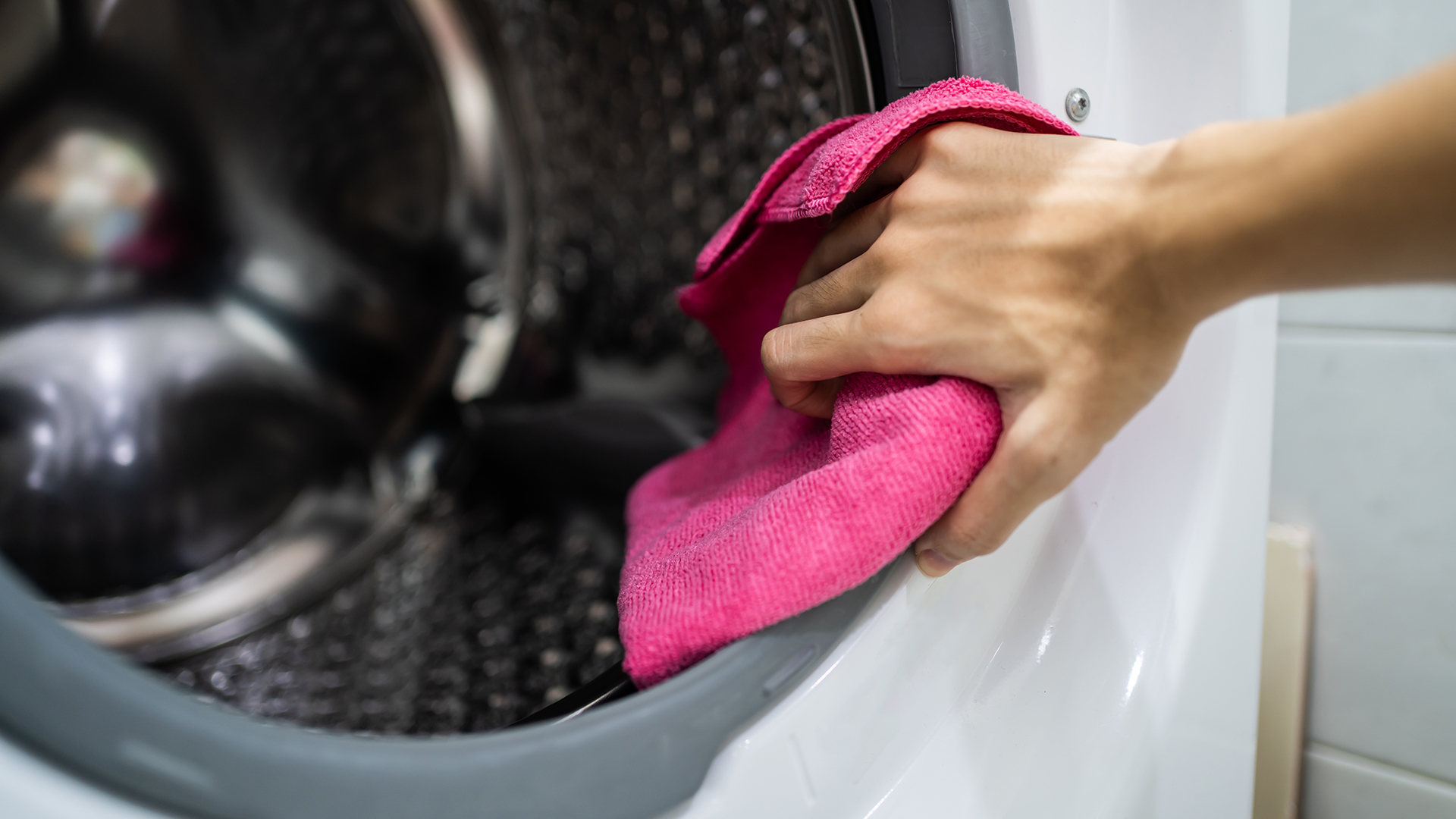
If the inside of your washing machine is starting to smell a little less than fresh, or a musty scent is transferring to your clean laundry, then you definitely need to know how to clean the drum of a washing machine.
After all, even the best washing machines - from front-loading washing machines to top-load washing machines - just like the best dryers and the best washer-dryers - need a regular spruce to keep them fresh.
Along with our experts, we guide you through how to spot the signs that your washing machine drum needs cleaning. Once you know the signs for when to cleanse your machine, simply follow the simple steps for how to clean the drum of a washing machine with minimal effort.
Our cleaning experts give us the best methods to sanitize your machine and ensure that your laundry comes out clean and fresh every time.
Be sure to also read our guide on how to clean a washing machine.
When should you clean the drum of a washing machine?
There are certain signs that your washing machine is ready to be deep cleaned; luckily, they are easy to spot before they get difficult to deal with. If you notice any of these signs, especially if they are building in intensity, then it’s time to read on and find out how to clean the drum of a washing machine.
• The biggest sign is a bad odor in the drum, in particular, a lingering musty smell that indicates mildew
• Your clothes are not coming out smelling fresh or totally clean
• Black spots are forming on the rubber seal of the washing machine
• The washer is having problems filling properly or with the water fully draining
All our experts advise you to keep on top of cleaning and caring for your washing machine.
What the expert says...
Domestic & General repair expert Ian-Palmer Smith provides a simple hack that you can include in your regular care and maintenance routine to keep your washer in tip-top condition.
Ian says: "The easiest way to clean out the drum of your washing machine is to run a maintenance wash cycle."
"A maintenance wash is essentially a deep-clean cycle that helps to kill off any bacteria, mold, and any stains or sludge that has built up."
"This is carried out by performing a very hot ‘cotton’ wash coupled with some washing machine cleaning solution."
"It is best to do this at least once a month to keep the washing machine nice and clean which in turn will keep your laundry clean and fresh too!"
How often should you clean the drum of a washing machine?
The annoying signs described above often happen because the conditions in the drum of the washing machine are moist and warm and can be an ideal breeding ground for bacteria, mold, and mildew when left unchecked in the holes of the washing machine drum.
Another factor is the products that we use in the machine. Professional cleaner Sally Dwyer tells us that “the build-up in a washing machine drum is often caused by using too much fabric softener.”
The excess cleaning products can become trapped in the divots and crevices of the washing machine drum, rubber seal, and coat the inside of the drainage pipe. The knock-on effect of this is water not draining properly, making the conditions in the drum even more likely to breed bacteria.
These unfortunate inherent design issues with washing machines mean it’s essential that you know how to clean the drum of a washing machine and get rid of excess build-up. You can do this as and when needed, but Sally cleans hers once a month.
What the expert says...
Laundry expert Sarah Dempsey advocates for a regular routine clean of your washing machine around once a month, along with more everyday maintenance.
Sarah explains: "After every use, make sure you leave the door and detergent drawer open to allow air to circulate and prevent the growth of mold. It’s also a good idea to check the drum and door seal are free from fluff."
"Wiping around the inside with a damp microfibre cloth is an effective way to remove lint and other trapped particles."
"Once a month, give your drum a bit of a sniff. If it has a stale smell, run a drum-cleaning cycle. You should also clean your drain pump filter every two to three months, depending on how frequently you use your machine."
"This is usually located on the front of your machine in the bottom left or right-hand corner. To clean this, you’ll need to make sure your machine is cool and then unplug it."
"Place a shallow tub underneath the filter cover and open it up. Turn the filter slightly to allow the water to empty out and then remove the filter completely."
"To clean the filter, run it under the cold tap and then replace it. Filters do vary between makes and models, so check your manual’s instructions before attempting to clean them."
"If you live in a hard water area, your machine may also need descaling every six months or so. There might be a program built in to help you do this or you may need to use a descaling product."
How to clean the drum of a washing machine
Follow the steps below to find out how to clean the drum of a washing machine. Keep in mind that the guide below is general, and you should always check the manual for your own washing machine first.
1. Wipe the rubber seal
Start by wiping the rubber seal on a cloth with white vinegar. You may want to use gloves to avoid the smell transferring to your hands. This should effectively remove any mold on the seal that the next stage of washing the drum doesn’t reach.
2. Go in with the bleach
Add a cap full of bleach to the drawer of the washing machine. Bleach makes an ideal cleaning agent to strip away excess product buildup, limescale, and bacteria and cleanse the drum and drainage pipe.
3. Pick an antibacterial cycle
Most modern washing machines will have a specific antibacterial setting that runs a washer cleaning cycle on preset settings that are optimal for the machine. If yours does not, just add the bleach to the drawers and run a standard-length hot wash. Check the manual for your machine to see if there is specific guidance on how to run a cleaning cycle manually.
Professional cleaner Sally Dwyer says, “I recommend doing a bleach wash at least every 2 to 3 months. I give my own washing machine a bleach wash on the antibacterial setting once a month.”
4. Clean the filter
Knowing how to clean the drum of a washing machine alone is not useful if the filter is clogged. The job of the filter is to prevent any dirt and debris from the drum from entering the drainage pipe to stop it from becoming blocked, but if it's full, it can allow dirty water to flow back and forth from the drainage pipe to the drum.
To clean the filter, it can normally be accessed behind a removable panel at the bottom of the machine, but if it’s not immediately apparent where it is then consult your machine’s manual. Clean it out with hot water and allow it to air dry before replacing it.
5. Don't forget the drawer
To stop excess product in the detergent drawer, immediately enter the washer drum again and clean the drawer. This is a removable component, so remove it and clean it using a dish brush and hot water. Make sure any gunky residue around the drawers is completely removed to stop it from entering the machine when the detergent is dispensed.
What the expert says...
Airtasker's editorial team expert Andrea Philips also shared Airtasker's top tips for cleaning washing machines with us:
1. Add 2 tablespoons of bicarbonate of soda into the detergent draw and 120ml of white vinegar into the washing machine drum.
2. Run a standard cycle with hot water.
3. Check the manufacturer’s guidelines on how to clean the filter. Filters are usually a contributing factor to poor washing results in a front loader.
4. If applicable, remove and clean the soap and fabric softener dispensers in hot soapy water and dry them out in the sun. This will prevent mold from forming and growing.
5. Leave the machine door ajar between washes to dry out properly and eliminate mold. (The machine might produce suds during the wash cycle due to the build up of residue. This will happen less if you clean your machine more frequently.)
Final thoughts
In addition to following our expert advice above, we always advocate that you consult the manufacturer's guidelines and manual to follow best practice guidelines for your specific model.
With these step-by-step instructions, tips, and techniques for cleaning the internal drum of your washing machine, as well as caring for maintaining other components of your washing machine, you can be sure to create a simple, yet effective and regular routine for cleaning and caring for your laundry appliance.
The best washing machines (like the best on offer below) work very hard for us, so the least we can do is to take care of them, and that will keep them in good working order for as long as possible.







